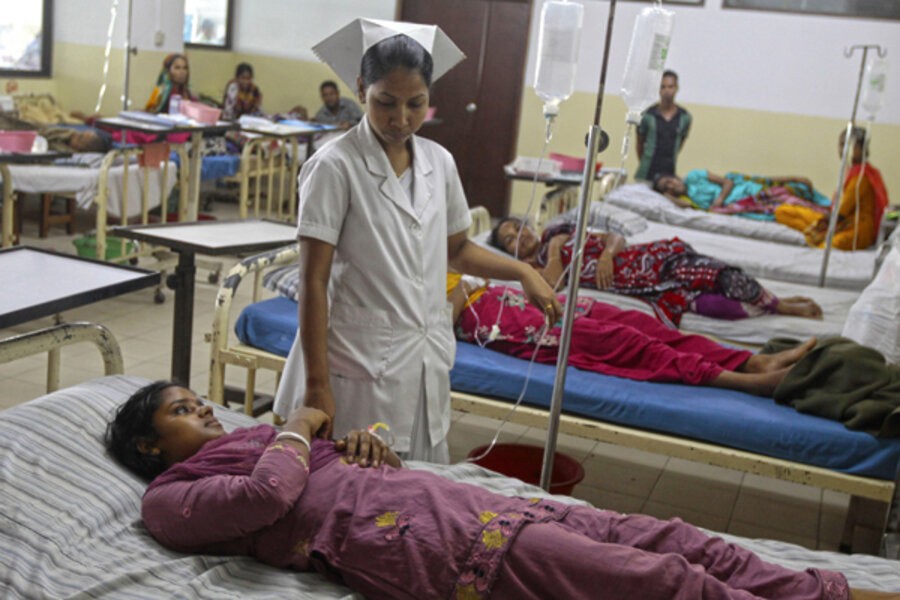Little research in occupational health and safety has been done to date in Bangladesh to identify the types of events, causes, or the specific groups of workers at risk of developing allergies or irritations at work, despite the persistent and serious nature of the exposure risk and the sizeable workforce in the healthcare industry.
Reports from 2019 state that the Ministry of Health and Family Welfare employed 151,532 individuals: 74,985 in the Directorate General of Health Services (DGHS), 41,282 in the Directorate General of Family Planning (DGFP) and 35,265 in the Directorate General of Nursing and Midwifery (DGNM). Over the past 20 years, Bangladesh has seen a number of its registered private hospitals grow from 1,125 to 4,452; clinics have grown from 411 to 1397; dental clinics have grown from 122 to 839; and diagnostic centers have grown from 1,778 to 10,291, according to the countrywide "Survey of Private Healthcare Institutions" conducted by the Bangladesh Bureau of Statistics (BBS).Despite the size of the healthcare workers in the public and private sector, research on their exposure to hazardous materials and the health consequences has not drawn attention from any quarters.
Healthcare professionals and workers in Bangladesh and across the world, particularly those employed in hospitals, are frequently exposed to various allergens and irritants. They may come into contact with chemicals, radiation, latex, dust, blood, and bodily fluids while performing various diagnostic and therapeutic procedures, working in laboratories, and performing preparation and cleanup operations. Chemical exposure is also a risk for those support workers doing maintenance, painting, plumbing, cleaning, and washing. Laboratory personnel come into contact with a wide variety of chemical reagents; pathologists deal with fixative and preservative solutions and histology technicians with dyes and stains. Moreover, a lot of healthcare professionals deal with anesthetic gases.
Pharmacists and nurses may experience allergic responses as a result of working with pharmaceuticals and chemicals. Chemical exposures that pose a risk to healthcare professionals include chemical disinfectants and sterilisers. Tissues can degrade thermally as a result of procedures like laser surgery, electro-cauterisation, and the use of various radiofrequency and high-energy equipment. While plumbers and soldering workers are exposed to lead and flux vapors; painters and maintenance personnel are exposed to solvents and lubricants. Employees in housekeeping are exposed to many chemicals, contained in soaps and detergents. The fumes from broiling and frying meals as well as nitrogen oxide released by natural gasses used as fuel are inhaled by cooks and food service personnel. A large proportion of health facility workers are engaged in non-patient care-providing tasks like doing facility operations, maintenance, cleaning, and providing food services for the hospital staff, patients, and their visitors.
The long-term health effects of several chemical reagents that cause allergies and reactions have been documented in earlier research. This research has looked into these exposures for specific industries (fertiliser, plastic, pharmaceuticals, battery), specific kinds of chemicals (formaldehyde, ethanol), or specific health outcomes (such as dermatitis or latex allergy). According to this author's (Dr. Alamgir's team) own research and analysis of all such occurrences involving a wide spectrum of healthcare professionals in Canada, significant risk of allergy and irritation incidents were documented among those working in the healthcare sector. The most vulnerable groups were younger workers, female workers, facility support service employees, laboratory assistants and technicians, maintenance employees, and employees at hospitals. These findings imply that prevention initiatives should be targeted to the high-risk groups. Many healthcare workers also work in non-hospital settings for example in research, administration, community care, and long-term care.
Hospitals do a vast range of work activities and handle a wide array of substances for the very nature of their operations. One explanation behind the difference in risk rates between male and female employees was that female employees were more likely to report such events or the alternate hypothesis was that women workers were assigned to jobs where they had regular exposure to hazardous materials. Previous studies have shown that women are more likely to get hurt when working in the medical industry.
It was assumed that older workers, perhaps from longer experience or understanding of potential hazards, would develop an ability to better protect themselves from fewer allergy and irritation occurrences. They would be more aware and searched for and used effective personal protective equipment (PPE) diligently.
The assessment and management of chemicals and other occupational exposures is one of the key components of an effective health and safety programme. Workplace controls are inherently superior to worker-level controls at the point of release or potential exposure, such as PPE. Workers take precautions to keep themselves away from areas where they might be exposed to hazardous materials when at all practicable
To protect body areas possibly exposed to chemicals, one can wear special protective clothes such as coveralls, aprons, head coverings, shoes, and boots. Some protection from chemical splashes is offered by face shields, respirators with full face pieces, and splash-proof chemical goggles. To stop the spread of allergies and other contaminants, employees should be told to wash their hands and face before eating and drinking.
Previous research evidence documents that worker education programmes, basic preventive measures, and hazard identification and reduction training can significantly lower the risk of injury among healthcare professionals. In the absence of research conducted locally, findings from other countries can be used to develop policies, and programmes to promote safer work practices in Bangladesh.
Afrin Nur is a student and
Dr. Hasnat M Alamgir is a Professor in the Department of Pharmacy at Southeast University.
hasnat.md.alamgir@gmail.com
Protecting healthcare workers from hazardous exposures
Afrin Noor and Hasnat M Alamgir | Published: September 12, 2024 21:42:05

Protecting healthcare workers from hazardous exposures
Share if you like
